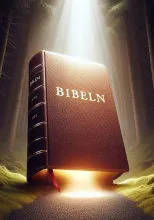Bible Facts 2
A few more notes about the Bible.
A Book Called “The Books”
Section titled “A Book Called “The Books””The word bible originates from the Greek τὰ βιβλία which approximately means the books. The word sometimes occurs in everyday language. For instance, you may mention a bible for stamp collectors. By that you mean a really heavy book where stamp collectors find all the information they need — the ultimate authority for stamp collectors.

Here at Bibelkraft we capitalize the word Bible when we refer
to the Christian Bible.
In traditional Christianity the Bible is the book where you find answers,
the ultimate authority.

The Bible As A Book
Section titled “The Bible As A Book”A modern Bible is a considerable tome nearing 2000 pages. The reason it is called The Books is that it consists of 66 books of varying length. It is divided into the Old Testament, with about three quarters of the number of pages, and the New Testament with one quarter, approximately.
Age And Languages
Section titled “Age And Languages”The Old Testament is, unsurprisingly, older than the New Testament, that is, over 2000 years. Parts of it may be 3500 years. The original text is mainly written in Hebrew, with some portions in Aramaic.
Hebrew is a living language which is currently spoken mainly in Israel. If you know modern Hebrew you can probably pick up much of the Old Testament in its original language. For an English speaker it may possibly be compared to reading the 1611 King James Bible.
Aramaic has forked out into several dialects and is still spoken by small groups of people. It seems, however, to be fading out of history.
The New Testament was written during the first century A.D., that is, about 2000 years ago. The original text is written in a classical Greek called koine which was spoken from around 300 B.C. until around 300 A.D. It was spread far and wide by the conquests of Alexander the Great. If you know modern Greek you may grasp much of the original text.
Origins
Section titled “Origins”The Bible consists of many books, as mentioned above. Even if the Bible text itself does not tell us a lot about its authors, it is clear that many different personalities express themselves through it. The books also represent a range of genres. There is history, law, poetry, prayers, wisdom, prophecy, personal letters, and more.
The origins of the Bible are thoroughly Jewish. It seems Luke, a physician who lived in the first century A.D., is the only non-Jewish Bible author. He wrote the Gospel of Luke and the Acts of the apostles in the New Testament.
What we call the Old Testament has always been, and still is, the foundation of Judaism (but then referred to as the Tanakh). In ancient times it did not take the shape of a book, but was a collection of scrolls that was extended during the centuries. The entire text simply did not fit into a single unit because the writing material at the time was much thicker than paper.
The New Testament was written after Jesus Christ was executed and then rose from the grave. That was the beginning of Christianity, and also the point where Christianity became distinct from Judaism.
Significance For Christianity
Section titled “Significance For Christianity”As an example of the significance of the Bible to Christianity, here is a fragment of the first paragraph of the first chapter of the founding document of the Church of Sweden (kyrkoordning) as of January 2025. (The translation is not authorized.)
The faith, confession, and doctrine of the Church of Sweden,
as expressed in divine service and life,
is founded on the holy Word of God, as handed down in the prophetic and apostolic writings of the Old and New Testaments …
Authenticity
Section titled “Authenticity”No originals have been preserved of either Old or New Testament texts. There was no printing press at the time, of course. All manuscripts are hand-written copies. (The word manuscript actually means written by hand.) So, can we really assume that the Bible text we read today has not been distorted over the course of history?
The New Testament
Section titled “The New Testament”The New Testament is, by far, the best documented of all ancient writings. Over 5000 manuscripts and fragments in original Greek are known. There are, in addition, an even greater number of ancient manuscripts in other languages of the time.
Just quotes from the Church Fathers cover large parts of the New Testament. The term Church Fathers refers to influential theologians and authors who contributed to the intellectual and doctrinal foundation of Christianity during the first centuries A.D.
Such a large amount of sources — still accumulating, by the way — means that the New Testament text, as we read it today, is certain to be very close to the original.
The Old Testament
Section titled “The Old Testament”The Old Testament has a more winding history. The oldest parts may have been relayed through oral transmission.
The books of the Old Testament have been holy to Judaism from the very start. It is reasonable to assume that they have been treated with great care and meticulously copied.
The oldest manuscripts known to us were, for a long time, from about 1000 A.D., the so-called Masoretic texts. The Masoretes developed an intricate system of checks to ensure that every copy was as perfect as possible. They used what computer programmers these days call checksums. They also marked unusual spelling of words to make sure that no one would, as it were, correct it. Sometimes they suspected that a copying error had actually crept into the text. Such cases were marked, but without being modified. Everything had to be faithfully copied.
In 1947 scrolls were found in desert caves near the Dead Sea. With that discovery manuscript history took a leap 1000 years back in time. The original texts had not changed in any notable way.
Research
Section titled “Research”There is copious work behind the Bible text available to us today. Many people have spent their lifetimes in a quest for accuracy. This means that the historic account above is very much simplified.
Bible researchers sometimes highlight variants of the text. What do they mean, in such case? Here is an example. Genesis 10:4 mentions a people called the Rodanim in recent Bible editions (like New International Version 2011, New American Bible 2010). Almost all earlier editions had the Dodanim. Letters d and r in the Hebrew alphabet (ד and ר, respectively) are similar, although the difference is greater in handwriting. Researchers have recently agreed that r is more probable than d in this case. (There is no upper and lower case distinction in Hebrew.)
Another example of recent research is dating of the book of Amos in the Old Testament. Amos 6:2 mentions three cities, well known at the time, that had been besieged and destroyed. Excavations in 2004 led to the conclusion that the largest of them, the city of Gath, was probably destroyed by king Hazael who ruled over what is now approximately Syria. His campaign is mentioned in 2 Kings 12:17-18. Before these discoveries it was generally believed that a later king was the one who raided Gath. Now the book of Amos may be dated to around 760 B.C.
Distribution, Translations
Section titled “Distribution, Translations”The Bible is by far the most widely distributed book in the world. Somewhere between 80 and 100 million Bibles are printed every year. Runner up is “The Little Red Book” by Mao Zedong with about a quarter of the number of copies, counting over the last 50 years. It got some help by being required reading for the over half a billion Chinese at the time of Mao.
The Bible reaches us through translations. According to Wycliffe Global Alliance the full Bible is translated into 756 languages (2025), while the New Testament is available in another 1726 languages.
Here, at Bibelkraft there is some
information on English translations.